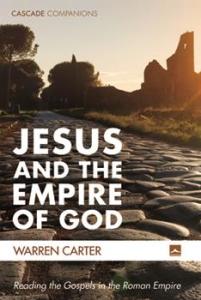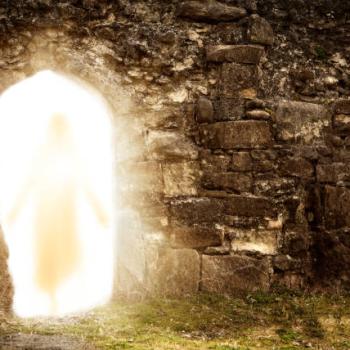
It’s common to read the New Testament for spiritual enlightenment and moral persuasion. One can also lower one’s sights and wonder about the political arena in which Jesus lived, worked, and suffered. That’s not as common, and when we do think that way, we tend to keep the two, Jesus and politics, apart from each other: “Render to Caesar Caesar’s due, and to God” … something else. Warren Carter rejects that separation and thinks a lot about politics in the New Testament. In Jesus and the Empire of God, Carter brings the first-century Palestinian world into his search for the meaning of the Scriptures. This background, especially the texts that described and made sense of the Roman imperial world, becomes foreground along with the New Testament texts. Carter calls his reading intertextual.
An intertextual reading
Intertextuality, for Carter, does not mean any obvious interdependence of texts one way or the other. Carter says,
[T]exts from quite different communities and traditions participate in various ways in common cultural contexts and interact with various other texts. (p.4)
Carter deals with texts only; that is, he works uncritically, not questioning the historicity of claims the texts make. In one of the discussion questions that follow a chapter on miracles, Carter asks,
Do you think healings such as miracles occur? (p. 122)
But he doesn’t answer, leaving such speculation to us. Carter is much more interested in the function and intertextuality of miracle stories in imperial and scriptural texts.
There are examples among the many imperial texts Carter cites that are surprisingly similar to New Testament stories. One could easily imagine some copying by a New Testament author. But Carter keeps away from any such historical connections, explaining,
I, as the author of this book, am responsible for creating this intertextuality or network between Gospel texts and Roman imperial texts.
And,
Cultural intertextuality is reader-centric, not author-centric. (p. 3)
Carter apparently declares here at the outset that he is dealing with meaning for the text’s reader, a meaning that is beyond an author’s control. Carter does not claim to reach back to the historical Jesus. Not even to the historical Church, which wrote about Jesus.
History
Still, there is a lot of history in this book, and the New Testament authors lived in that history:
I am interested in thinking about the New Testament writings as participants in networks of texts from the Roman Empire in the first and second centuries CE. (p. 4)
There are “interactions” among these texts, Carter claims. I don’t think these interactions could be just in our minds. They must be truly historical interactions, even if unconsciously, in the minds of New Testament authors and original readers. I don’t know if Carter agrees, but consider:
The New Testament writings participate in this system of imperial domination…. In places they appear to submit to and cooperate with imperial rule. But they also dissent from Rome’s societal vision, practices, and structures….
They imagine and advocate
… alternative commitments and ways of being human shaped by God’s purposes and Jesus’ teaching. (p. 18)
A sacred writer may not be able to name all of Carter’s 15 or so characteristics of an oppressive imperial system, but he knows when he’s going against the grain, even when all he wants to do is follow Jesus. I suspect Jesus himself sometimes deliberately aimed his teaching at an overbearing culture of empire.
Multitudes of texts and stories
For a history buff, Carter supplies a satisfying array of texts from the Roman and Greek classic era. In every case he finds mimicry, cooptation, and also dissent in the New Testament. Chapters present imperial texts and comparable New Testament texts in these areas:
- Origins – Chapter 3
- Portents of greatness – Chapter 4
- Teachings about social structures and practices – Chapter 5
- Miracles, signs, and wonders – Chapter 6
The imperial stories always glorify what already is or has been, namely, the Roman Empire, an emperor, or some other important figure. The New Testament stories, like the ancient biographies that Carter says they are, also glorify. But they glorify what is to come – the “Empire of God” and the coming victorious “Son of Man.”
Carter finds more similarities and differences between imperial literature and the New Testament in chapters dealing with the end of Jesus’ career on earth:
- Chapter 7, Jesus’ entry into Jerusalem
- Chapter 8, Jesus’ death
- Chapter 9, Jesus’ resurrection, ascension, and return
Probably the New Testament’s most obvious dissent from imperial ways of thinking is in the stories of Jesus’ death. In the Roman Empire an honorable death is a convincing mark of a person’s greatness. Jesus’ death is anything but honorable in the eyes of the world. Yet Christians found a way to exhibit the cross as a badge of honor. Jesus’ death “becomes a symbol of faithfulness to God’s purpose.” (p. 37)
Empire then and today
Carter sometimes startles the reader with original translations, for instance:
Repent, for the empire of the heavens has come near. (p. 81, Matthew)
The Greek term basileia becomes “kingdom” in most New Testament translation. But that term “names various empires: Babylon, Media, Persia, Macedonia, the Seleucids, and the contemporary Roman Empire” (p. 94). It was not just any kingdom that God and subject peoples of the first-century Mediterranean dealt with but worldwide power. Today, when we think of wide-ranging worldly power, we don’t think kingdom but empire. Imperial nations still treat other nations as colonies. The worldwide dominance of multinational corporations forms another kind of empire. Carter is clear and insistent about one of the purposes of his intertextual reading:
I suggest that engaging the Gospels’ intertextuality with the imperial-cultural texts of the Roman Empire foregrounds matters of societal visions, practices, structures, and personnel, both ancient and contemporary. Such intertextualities provoke us to think about the impact of the use of power and privilege in our world. (p. 6)
Lightning, eagles and vultures
Carter’s intertextual reading extends to “texts” other than literary forms. He explains:
I use “text” to refer to non-written “texts” such as monuments, buildings, statues, and coins that make statements about imperial power. (p. 4)
Carter’s use of one such non-literary “text” helped me make sense of a difficult New Testament passage. Again he brings empire into the foreground, where otherwise it wasn’t even in the background, at least not for me.
Just as lightning comes from the east and is seen as far as the west, so will the coming of the Son of Man be. Wherever the corpse is there the eagles will be gathered. (Matthew 24:27-28)
Carter’s intertextual reading sees in the lightning of that first sentence more than a highly visible display. It’s a sign of the authority of the Roman Empire and its high God, Zeus. First, the Son of Man rivals that authority. Then, in the second sentence, he subverts it. The eagles there are not just birds but standards that Roman armies carried into battle. Usually one reads “vultures” instead of “eagles.” Most often it’s vultures that gather around dead bodies. But “eagle” is the ordinary meaning of the Greek aetos, and now they aren’t gathering, but they are gathered. They’re lying in the dust with the dead and dying soldiers of Rome. (p. 187)
I like this intertextual reading better than the thought that Jesus, or Matthew, would make vultures a sign of God’s Kingdom or compare the Kingdom itself to a corpse. I suspect that here Carter is not just gathering disparate texts together but actually getting into Matthew’s mind. If so, then God’s empire, as Matthew sees it, is not just highly visible – light lightning and vultures soaring – but also highly disruptive of worldly empire.
For Matthew the end of this age of the world would entail the end of the Roman Empire. For us, then, the Christian hope for God’s Empire must take deliberate aim at the empires of today’s world.
More than spiritual documents
Carter contends with a common way of reading the Gospels:
As spiritual texts they are often understood by contemporary readers as concerning an individual’s spiritual and individual relationship with God. Often this approach isolates Gospels from everyday matters and practices, from societal structures and political practices. [An intertextual reading] alerts us to the Gospels as documents of political import. These intertextualities expand our horizons and disrupt spiritualizing reading strategies. They frame the Gospels as concerned with power structures, societal practices, leadership, social relationships, beneficiaries and casualties, who has access to and who is excluded from good resources of food, healthcare, housing, safety, and justice. The Gospels envision a different world and different priorities. (p. 195-96)
I found in Carter’s intertextual reading a confirmation of the direction I have taken in many posts. The Gospels show at least as much concern for life in this world as in the next. As I have claimed, for example, in a series of posts on the Gospel of Mark, there is a spirituality in the Gospels that is quite worldly.













